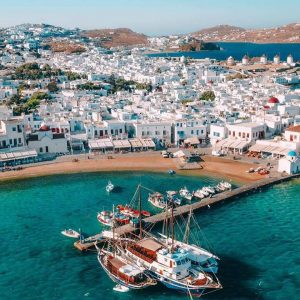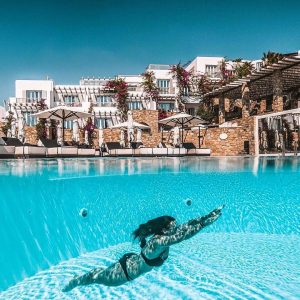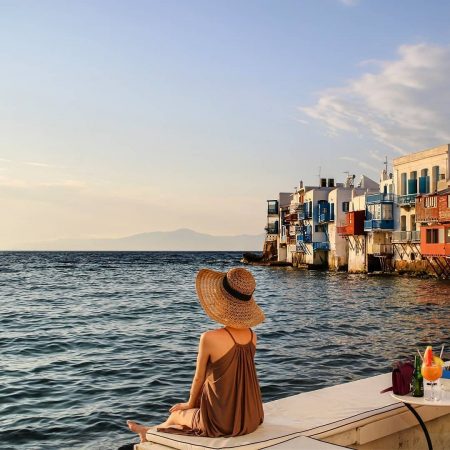Mykonos history spans over a 3.000 years period, beginning at the Late Bronze Age till the Greek Revolution and the 1950s with the flourishing of tourism!
Mythology
According to classical mythology, the Giants killed by Hercules in a fierce battle, are buried on the island under imposing blocks of Mykonian granite. The name “Mykonos”, somewhat pejoratively, means a mass of stones’ or a rocky place.

A later tradition attributes the name of the island to a hero by the name of Mykonos, the son of the king of Delos, Anios, who was the son of Appolon and nymph Rhoio- a descendent of Dionysus.
Historical sources confirm that in ancient times there were two towns on the island. In 490B.C, the Persian generals Datis and Artaphernes made a brief stopover in Mykonos. It was a poor island with limited agricultural resources.
In ancient, pantheistic times, Dionysos, Demetra, Zeus, Appolon, Poseidon, and also Heracles were the principal gods here. Later in history, Mykonos island belonged to the Romans and subsequently to the Byzantines. They have fortified the island against the Arab raids of the 7th century and kept control of it until the 12th century.
Medieval Period (A.D. 1200-1800)
After the fall of Constantinople, at the end of the 4th Crusade (1204), the island was occupied, by Andrea and Jeremia Ghisi, relatives of the Doge of Venice.
In 1292 it was looted and pillage by the Catalans, and subsequently in 1390 given over to the Venetians. In 1537 while still under Venetian domination, the island suffered a catastrophic attack by Barbarossa, the admiral of Souleiman the Magnificent.

The popularity of Mykonos island was increased by colonies of immigrants from nearby islands and Crete. Starvation and epidemics followed also by periods of conflict, were common until the late 18th century.
The Mykonians throughout the same period were also famous as excellent sailors. Furthermore, they were successful in trade and shipping and also sometimes in piracy. Many islanders were active in the “Orlof Insurrection”, which resulted favorably for them. This happened due to the very profitable treaties concerning trade between the Ottomans and the Russian Empire.

Soon after the outbreak of the Greek Revolution in 1821, the Mykonians roused and led by the lady Manto Mavrogenous (an- aristocrat educated with the most fervent ideas of the Enlightenment and popular nation heroine) successfully impeded a landing of a squadron of the Ottoman fleet in 1822.
They participated actively in the war, with four armed ships that two of them were supplied at Lady Manto’s expense. Before the war was over she had spent all of her considerable, family fortunes supporting the independence revolution.
Twentieth-Century
After the establishment of the modern Greek State, the activity of the locals revived the island’s economy. This was mostly achieved through trade relations with south Russia, Moldavia, and Walachia. Furthermore, Mykonian merchants were also doing business in Constantinople, Smyrna, Alexandria, Syros, Livorno, and Marseille.

At the end of the 19th century, the predominance of stream technology over the traditional commerce of the sailing ships seriously affected the island’s economy. Furthermore, the subsequent opening of the Corinth Canal (1904) and also World War I, resulted in the further economic depression. Many Mykonians left to find work abroad. Many went to the US while others in the mainland of Greece (Piraeus, Athens). The development of tourism in the following decades has provided a means of the islands’ economic development.

In the early 1930s already, many famous artists, politicians, and also wealthy people began spending a vacation on the island. Attracted by the island’s unique atmosphere, most of them came from Europe and the US.
Mykonos island has adapted well to the post-war situation and the gradual growth of the tourism industry in south Europe. It quickly became a cosmopolitan locale and also one of the most successful growth – models, of its type and scale in Europe.



